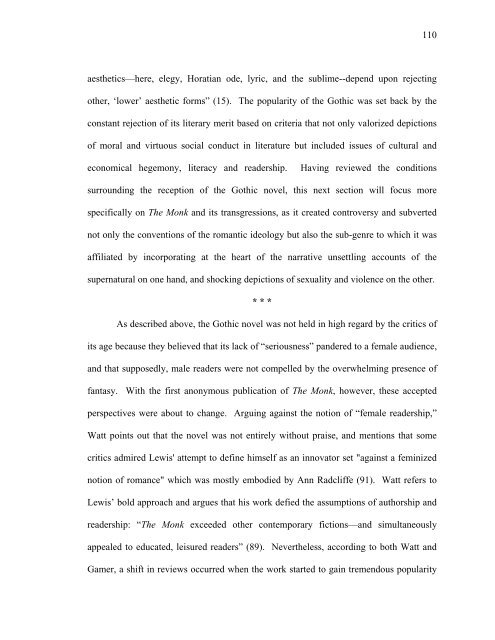Untitled - Sexey's School Moodle
Untitled - Sexey's School Moodle
Untitled - Sexey's School Moodle
Create successful ePaper yourself
Turn your PDF publications into a flip-book with our unique Google optimized e-Paper software.
aesthetics—here, elegy, Horatian ode, lyric, and the sublime--depend upon rejecting<br />
other, ‘lower’ aesthetic forms” (15). The popularity of the Gothic was set back by the<br />
constant rejection of its literary merit based on criteria that not only valorized depictions<br />
of moral and virtuous social conduct in literature but included issues of cultural and<br />
economical hegemony, literacy and readership. Having reviewed the conditions<br />
surrounding the reception of the Gothic novel, this next section will focus more<br />
specifically on The Monk and its transgressions, as it created controversy and subverted<br />
not only the conventions of the romantic ideology but also the sub-genre to which it was<br />
affiliated by incorporating at the heart of the narrative unsettling accounts of the<br />
supernatural on one hand, and shocking depictions of sexuality and violence on the other.<br />
* * *<br />
110<br />
As described above, the Gothic novel was not held in high regard by the critics of<br />
its age because they believed that its lack of “seriousness” pandered to a female audience,<br />
and that supposedly, male readers were not compelled by the overwhelming presence of<br />
fantasy. With the first anonymous publication of The Monk, however, these accepted<br />
perspectives were about to change. Arguing against the notion of “female readership,”<br />
Watt points out that the novel was not entirely without praise, and mentions that some<br />
critics admired Lewis' attempt to define himself as an innovator set "against a feminized<br />
notion of romance" which was mostly embodied by Ann Radcliffe (91). Watt refers to<br />
Lewis’ bold approach and argues that his work defied the assumptions of authorship and<br />
readership: “The Monk exceeded other contemporary fictions—and simultaneously<br />
appealed to educated, leisured readers” (89). Nevertheless, according to both Watt and<br />
Gamer, a shift in reviews occurred when the work started to gain tremendous popularity



